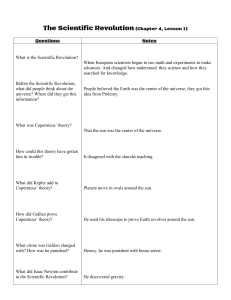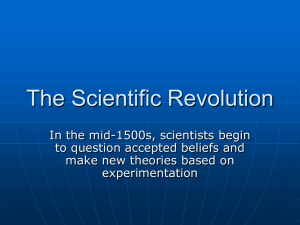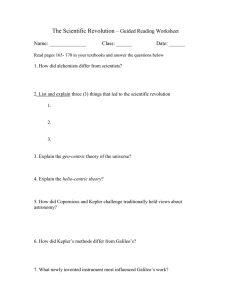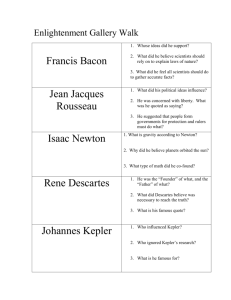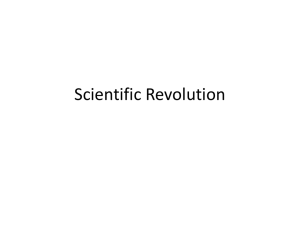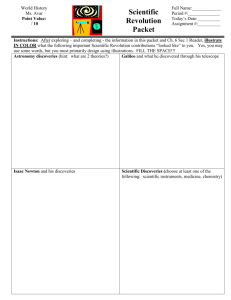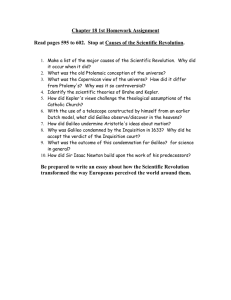Uploaded by
TechBench
Scientific Revolution: Key Figures & Theories
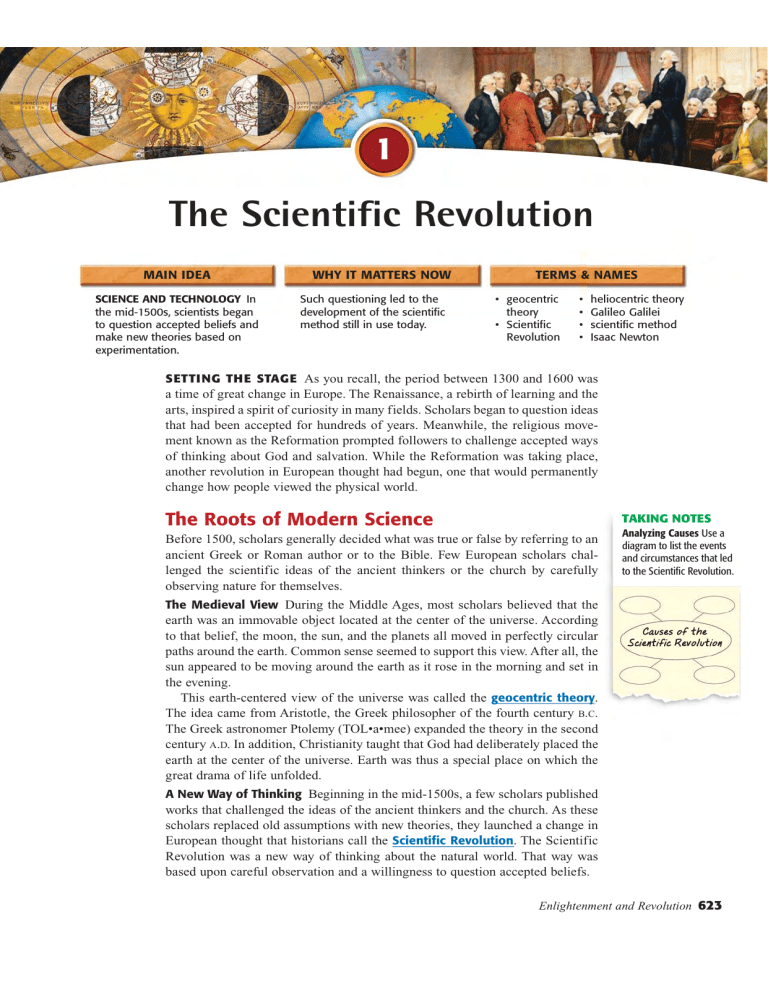
1 The Scientific Revolution MAIN IDEA SCIENCE AND TECHNOLOGY In the mid-1500s, scientists began to question accepted beliefs and make new theories based on experimentation. WHY IT MATTERS NOW Such questioning led to the development of the scientific method still in use today. TERMS & NAMES • geocentric theory • Scientific Revolution • • • • heliocentric theory Galileo Galilei scientific method Isaac Newton SETTING THE STAGE As you recall, the period between 1300 and 1600 was a time of great change in Europe. The Renaissance, a rebirth of learning and the arts, inspired a spirit of curiosity in many fields. Scholars began to question ideas that had been accepted for hundreds of years. Meanwhile, the religious movement known as the Reformation prompted followers to challenge accepted ways of thinking about God and salvation. While the Reformation was taking place, another revolution in European thought had begun, one that would permanently change how people viewed the physical world. The Roots of Modern Science TAKING NOTES Before 1500, scholars generally decided what was true or false by referring to an ancient Greek or Roman author or to the Bible. Few European scholars challenged the scientific ideas of the ancient thinkers or the church by carefully observing nature for themselves. Analyzing Causes Use a diagram to list the events and circumstances that led to the Scientific Revolution. The Medieval View During the Middle Ages, most scholars believed that the earth was an immovable object located at the center of the universe. According to that belief, the moon, the sun, and the planets all moved in perfectly circular paths around the earth. Common sense seemed to support this view. After all, the sun appeared to be moving around the earth as it rose in the morning and set in the evening. This earth-centered view of the universe was called the geocentric theory. The idea came from Aristotle, the Greek philosopher of the fourth century B.C. The Greek astronomer Ptolemy (TOL•a•mee) expanded the theory in the second century A.D. In addition, Christianity taught that God had deliberately placed the earth at the center of the universe. Earth was thus a special place on which the great drama of life unfolded. Causes of the Scientific Revolution A New Way of Thinking Beginning in the mid-1500s, a few scholars published works that challenged the ideas of the ancient thinkers and the church. As these scholars replaced old assumptions with new theories, they launched a change in European thought that historians call the Scientific Revolution. The Scientific Revolution was a new way of thinking about the natural world. That way was based upon careful observation and a willingness to question accepted beliefs. Enlightenment and Revolution 623 A combination of discoveries and circumstances led to the Scientific Revolution and helped spread its impact. During the Renaissance, European explorers traveled to Africa, Asia, and the Americas. Such lands were inhabited by peoples and animals previously unknown in Europe. These discoveries opened Europeans to the possibility that there were new truths to be found. The invention of the printing press during this period helped spread challenging ideas—both old and new— more widely among Europe’s thinkers. The age of European exploration also fueled a great deal of scientific research, especially in astronomy and mathematics. Navigators needed better instruments and geographic measurements, for example, to determine their location in the open sea. As scientists began to look more closely at the world around them, they made observations that did not match the ancient beliefs. They found they had reached the limit of the classical world’s knowledge. Yet, they still needed to know more. A Revolutionary Model of the Universe An early challenge to accepted scientific thinking came in the field of astronomy. It started when a small group of scholars began to question the geocentric theory. The Heliocentric Theory Although backed by authority and common sense, the Saturn ▲ This model shows how Copernicus saw the planets revolving around the sun. 624 Chapter 22 geocentric theory did not accurately explain the movements of the sun, moon, and planets. This problem troubled a Polish cleric and astronomer named Nicolaus Copernicus (koh•PUR•nuh•kuhs). In the early 1500s, Copernicus became interested in an old Greek idea that the sun stood at the center of the universe. After studying planetary movements for more than 25 years, Copernicus reasoned that indeed, the stars, the earth, and the other planets revolved around the sun. Copernicus’s heliocentric, or suncentered, theory still did not completely explain why the planets orbited the way they did. He also the stars Venus Earth knew that most scholars and clergy Mars Sun Mercury Jupiter would reject his theory because it contradicted their religious views. Fearing ridicule or persecution, Copernicus did not publish his findings until 1543, the last year of his life. He received a copy of his book, On the Revolutions of the Heavenly Bodies, on his deathbed. While revolutionary, Copernicus’s book caused little stir at first. Over the next century and a half, other scientists built on the foundations he had laid. A Danish astronomer, Tycho Brahe (TEE•koh brah), carefully recorded the movements of the planets for many years. Brahe produced mountains of accurate data based on his observations. However, it was left to his followers to make mathematical sense of them. After Brahe’s death in 1601, his assistant, a brilliant mathematician named Johannes Kepler, continued his work. After studying Brahe’s data, Kepler concluded that certain mathematical laws govern planetary motion. One of these laws showed that the planets revolve around the sun in elliptical orbits instead of circles, as was previously thought. Kepler’s laws showed that Copernicus’s basic ideas were true. They demonstrated mathematically that the planets revolve around the sun. Recognizing Effects How did Kepler’s findings support the heliocentric theory? Galileo’s Discoveries An Italian scientist named Galileo Galilei built on the new theories about astronomy. As a young man, Galileo learned that a Dutch lens maker had built an instrument that could enlarge far-off objects. Galileo built his own telescope and used it to study the heavens in 1609. Then, in 1610, he published a small book called Starry Messenger, which described his astonishing observations. Galileo announced that Jupiter had four moons and that the sun had dark spots. He also noted that the earth’s moon had a rough, uneven surface. This shattered Aristotle’s theory that the moon and stars were made of a pure, perfect substance. Galileo’s observations, as well as his laws of motion, also clearly supported the theories of Copernicus. Conflict with the Church Galileo’s findings frightened both Catholic and Protes- tant leaders because they went against church teaching and authority. If people believed the church could be wrong about this, they could question other church teachings as well. In 1616, the Catholic Church warned Galileo not to defend the ideas of Copernicus. Although Galileo remained publicly silent, he continued his studies. Then, in 1632, he published Dialogue Concerning the Two Chief World Systems. This book presented the ideas of both Copernicus and Ptolemy, but it clearly showed that Galileo supported the Copernican theory. The pope angrily summoned Galileo to Rome to stand trial before the Inquisition. Galileo stood before the court in 1633. Under the threat of torture, he knelt before the cardinals and read aloud a signed confession. In it, he agreed that the ideas of Copernicus were false. Analyzing Primary Sources In what two ways does Galileo seek to appease the Church? PRIMARY SOURCE With sincere heart and unpretended faith I abjure, curse, and detest the aforesaid errors and heresies [of Copernicus] and also every other error . . . contrary to the Holy Church, and I swear that in the future I will never again say or assert . . . anything that might cause a similar suspicion toward me. GALILEO GALILEI, quoted in The Discoverers Galileo was never again a free man. He lived under house arrest and died in 1642 at his villa near Florence. However, his books and ideas still spread all over Europe. (In 1992, the Catholic Church officially acknowledged that Galileo had been right.) ▲ Galileo stands before the papal court. The Scientific Method The revolution in scientific thinking that Copernicus, Kepler, and Galileo began eventually developed into a new approach to science called the scientific method. The scientific method is a logical procedure for gathering and testing ideas. It begins with a problem or question arising from an observation. Scientists next form a hypothesis, or unproved assumption. The hypothesis is then tested in an experiment or on the basis of data. In the final step, scientists analyze and interpret their data to reach a new conclusion. That conclusion either confirms or disproves the hypothesis. Enlightenment and Revolution 625 1609 Kepler publishes first two laws of planetary motion. 1566 Marie de Coste Blanche publishes The Nature of the Sun and Earth. 1520 1570 1543 Copernicus publishes heliocentric theory. Vesalius publishes human anatomy textbook. ▲ Nicolaus Copernicus began the Scientific Revolution with his heliocentric theory. 1610 Galileo publishes Starry Messenger. 1620 1590 Janssen invents microscope. 1620 Bacon’s book Novum Organum (New Instrument) encourages experimental method. Bacon and Descartes The scientific method did not develop overnight. The work of two important thinkers of the 1600s, Francis Bacon and René Descartes (day•KAHRT), helped to advance the new approach. Francis Bacon, an English statesman and writer, had a passionate interest in science. He believed that by better understanding the world, scientists would generate practical knowledge that would improve people’s lives. In his writings, Bacon attacked medieval scholars for relying too heavily on the conclusions of Aristotle and other ancient thinkers. Instead of reasoning from abstract theories, he urged scientists to experiment and then draw conclusions. This approach is called empiricism, or the experimental method. In France, René Descartes also took a keen interest in science. He developed analytical geometry, which linked algebra and geometry. This provided an important new tool for scientific research. Like Bacon, Descartes believed that scientists needed to reject old assumptions and teachings. As a mathematician, however, he approached gaining knowledge differently than Bacon. Rather than using experimentation, Descartes relied on mathematics and logic. He believed that everything should be doubted until proved by reason. The only thing he knew for certain was that he existed—because, as he wrote, “I think, therefore I am.” From this starting point, he followed a train of strict reasoning to arrive at other basic truths. Modern scientific methods are based on the ideas of Bacon and Descartes. Scientists have shown that observation and experimentation, together with general laws that can be expressed mathematically, can lead people to a better understanding of the natural world. Newton Explains the Law of Gravity By the mid-1600s, the accomplishments of Copernicus, Kepler, and Galileo had shattered the old views of astronomy and physics. Later, the great English scientist Isaac Newton helped to bring together their breakthroughs under a single theory of motion. Changing Idea: Scientific Method Old Science Scholars generally relied on ancient authorities, church teachings, common sense, and reasoning to explain the physical world. 626 Chapter 22 New Science In time, scholars began to use observation, experimentation, and scientific reasoning to gather knowledge and draw conclusions about the physical world. Contrasting How did Descartes’s approach to science differ from Bacon’s? 1628 Harvey reveals how human heart functions. 1637 Descartes’s book Discourse on Method sets forth his scientific method of reasoning from the basis of doubt. 1620 1633 Galileo faces Inquisition for support of Copernicus’s theory. Clarifying Why was the law of gravitation important? 1662 Boyle discovers mathematical relationship between the pressure and volume of gases, known as Boyle’s law. 1674 Leeuwenhoek observes bacteria through microscope. 1714 Fahrenheit invents mercury thermometer. 1670 1643 Torricelli invents barometer. 1666 France establishes Academy of Sciences. 1660 England establishes Royal Society to support scientific study. 1720 1687 Newton publishes law of gravity. Newton studied mathematics and physics at Cambridge University. By the time he was 26, Newton was certain that all physical objects were affected equally by the same forces. Newton’s great discovery was that the same force ruled motion of the planets and all matter on earth and in space. The key idea that linked motion in the heavens with motion on the earth was the law of universal gravitation. According to this law, every object in the universe attracts every other object. The degree of attraction depends on the mass of the objects and the distance between them. In 1687, Newton published his ideas in a work called The Mathematical Principles of Natural Philosophy. It was one of the most important scientific books ever written. The universe he described was like a giant clock. Its parts all worked together perfectly in ways that could be expressed mathematically. Newton believed that God was the creator of this orderly universe, the clockmaker who had set everything in motion. ▲ Isaac Newton’s law of gravity explained how the same physical laws governed motion both on earth and in the heavens. The Scientific Revolution Spreads As astronomers explored the secrets of the universe, other scientists began to study the secrets of nature on earth. Careful observation and the use of the scientific method eventually became important in many different fields. Scientific Instruments Scientists developed new tools and instruments to make the precise observations that the scientific method demanded. The first microscope was invented by a Dutch maker of eyeglasses, Zacharias Janssen (YAHN•suhn), in 1590. In the 1670s, a Dutch drapery merchant and amateur scientist named Anton van Leeuwenhoek (LAY•vuhn•HUK) used a microscope to observe bacteria swimming in tooth scrapings. He also examined red blood cells for the first time. In 1643, one of Galileo’s students, Evangelista Torricelli (TAWR•uh•CHEHL•ee), developed the first mercury barometer, a tool for measuring atmospheric pressure and predicting weather. In 1714, the German physicist Gabriel Fahrenheit (FAR•uhn•HYT) made the first thermometer to use mercury in glass. Fahrenheit’s thermometer showed water freezing at 32°. A Swedish astronomer, Anders Celsius (SEHL•see•uhs), created another scale for the mercury thermometer in 1742. Celsius’s scale showed freezing at 0°. Medicine and the Human Body During the Middle Ages, European doctors had accepted as fact the writings of an ancient Greek physician named Galen. However, Galen had never dissected the body of a human being. Instead, he had studied the anatomy of pigs and other animals. Galen assumed that human anatomy was much the same. A Flemish physician named Andreas Vesalius proved Galen’s assumptions wrong. Vesalius dissected human corpses and published his observations. His Enlightenment and Revolution 627 book, On the Structure of the Human Body (1543), was filled with detailed drawings of human organs, bones, and muscle. In the late 1700s, British physician Edward Jenner introduced a vaccine to prevent smallpox. Inoculation using live smallpox germs had been practiced in Asia for centuries. While beneficial, this technique could also be dangerous. Jenner discovered that inoculation with germs from a cattle disease called cowpox gave permanent protection from smallpox for humans. Because cowpox was a much milder disease, the risks for this form of inoculation were much lower. Jenner used cowpox to produce the world’s first vaccination. ▲ The famous Dutch painter Rembrandt painted Anatomy Lesson of Dr. Tulp in 1632 from an actual anatomy lesson. The corpse was that of a criminal. SECTION Vocabulary Inoculation is the act of injecting a germ into a person’s body so as to create an immunity to the disease. Discoveries in Chemistry Robert Boyle pioneered the use of the scientific method in chemistry. He is considered the founder of modern chemistry. In a book called The Sceptical Chymist (1661), Boyle challenged Aristotle’s idea that the physical world consisted of four elements—earth, air, fire, and water. Instead, Boyle proposed that matter was made up of smaller primary particles that joined together in different ways. Boyle’s most famous contribution to chemistry is Boyle’s law. This law explains how the volume, temperature, and pressure of gas affect each other. The notions of reason and order, which spurred so many breakthroughs in science, soon moved into other fields of life. Philosophers and scholars across Europe began to rethink long-held beliefs about the human condition, most notably the rights and liberties of ordinary citizens. These thinkers helped to usher in a movement that challenged the age-old relationship between a government and its people, and eventually changed forever the political landscape in numerous societies. 1 ASSESSMENT TERMS & NAMES 1. For each term or name, write a sentence explaining its significance. • geocentric theory • Scientific Revolution • heliocentric theory • Galileo Galilei • scientific method • Isaac Newton USING YOUR NOTES MAIN IDEAS CRITICAL THINKING & WRITING 2. Which event or circumstance 3. Before the 1500s, who and 6. DRAWING CONCLUSIONS “If I have seen farther than do you consider to be the most significant? Why? what were the final authorities with regard to most knowledge? 4. How did the heliocentric theory of the universe differ from the geocentric theory? Causes of the Scientific Revolution 5. What are the main steps of the scientific method? others,” said Newton, “it is because I have stood on the shoulders of giants.” Could this be said of most scientific accomplishments? Explain. 7. ANALYZING MOTIVES Why might institutions of authority tend to reject new ideas? 8. FORMING AND SUPPORTING OPINIONS Do you agree with Galileo’s actions during his Inquisition? Explain. 9. WRITING ACTIVITY SCIENCE AND TECHNOLOGY Create a television script for a discovery of the Scientific Revolution. Include key people, ideas, and accomplishments. CONNECT TO TODAY CREATING A GRAPHIC Research a modern-day invention or new way of thinking and then describe it and its impact on society to the class in a poster or annotated diagram. 628 Chapter 22
